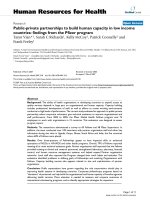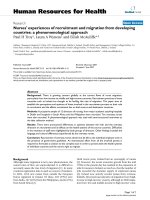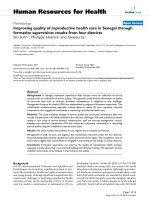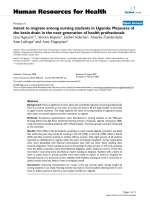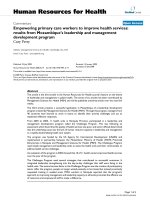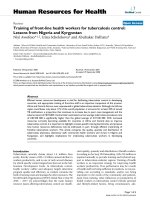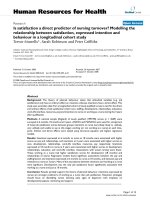báo cáo sinh học:" Nursing brain drain from India" ppt
Bạn đang xem bản rút gọn của tài liệu. Xem và tải ngay bản đầy đủ của tài liệu tại đây (169.98 KB, 2 trang )
BioMed Central
Page 1 of 2
(page number not for citation purposes)
Human Resources for Health
Open Access
Commentary
Nursing brain drain from India
Michael Hawkes*
1
, Mary Kolenko
2
, Michelle Shockness
3
and
Krishna Diwaker
4
Address:
1
Institute of Medical Sciences, University of Toronto, Toronto, Canada,
2
Faculty of Nursing, University of Toronto, Toronto, Canada,
3
Urban Promise, Toronto, Canada and
4
Department of Neonatology, Department of Pediatrics, Malankara Orthodox Syrian Church Medical
College, Kolencherry, India
Email: Michael Hawkes* - ; Mary Kolenko - ;
Michelle Shockness - ; Krishna Diwaker -
* Corresponding author
Abstract
In response to recent findings regarding migration of health workers out of Africa, we provide data
from a survey of Indian nurses suggesting that up to one fifth of the nursing labour force may be
lost to wealthier countries through circular migration.
Introduction
Migration of trained nurses from resource-poor countries
to wealthier countries experiencing nursing shortages may
exacerbate global health care inequities [1]. We wish to
draw attention to the significant drain on India's nursing
labour force due to "circular migration," using selected
results from a recent survey.
Discussion
We administered anonymous written questionnaires to a
convenience sample of 99 nurses at a private hospital
(Malankara Orthodox Syrian Church Medical College) in
Kerala, India, in September 2007. Study participants had
a median age of 27 years (range 22 to 57) and 96% were
female. In terms of educational background, 98% of
respondents had obtained a three-year nursing diploma
while 2% had a four-year bachelor's degree in nursing. Of
note, 20% of respondents had worked abroad, for a
median of six years (range 2 to 15 years). Career time
spent outside India accounted for 145 person-years (19%)
out of a total of 621 person-years of total work experience
reported in the survey. The receiving countries were:
Oman (n = 4), Saudi Arabia (11) and Singapore (1).
Working abroad was associated with older age (median
38 years versus 26 years, p < 0.001), more work experience
(median 16 years versus four years, p < 0.001), and nurs-
ing seniority (44% of charge nurses versus 11% of staff
nurses had worked abroad, p = 0.004).
With its high literacy rates and progressive education pro-
grammes, the state of Kerala trains a nursing workforce
that is highly sought-after in the global labour market [2].
More than 50% of new nurse registrants in the United
Kingdom in 2001 were from India, representing 0.21% of
India's total nursing stock, and a comparable and increas-
ing number of Indian nurses migrate to the United States
of America annually [3]. The nursing workforce of Saudi
Arabia, where most survey respondents had served a term
abroad, is composed 83% to 95% of foreign nurses [4],
many from South Asian countries [5].
Previous authors have noted that the Eastern Mediterra-
nean is a common destination for the "circular migration"
of Indian nurses, whereby nurses – motivated by higher
salaries – work abroad temporarily, then return to their
country of origin [6]. Consistent with this observation,
Published: 2 February 2009
Human Resources for Health 2009, 7:5 doi:10.1186/1478-4491-7-5
Received: 11 February 2008
Accepted: 2 February 2009
This article is available from: />© 2009 Hawkes et al; licensee BioMed Central Ltd.
This is an Open Access article distributed under the terms of the Creative Commons Attribution License ( />),
which permits unrestricted use, distribution, and reproduction in any medium, provided the original work is properly cited.
Human Resources for Health 2009, 7:5 />Page 2 of 2
(page number not for citation purposes)
older and more experienced nurses were more likely to
have worked abroad in our cross-sectional survey, repre-
senting a significant group of nurses who had returned to
India after a sojourn abroad.
It has been argued that circular migration does not pro-
duce the same degree of loss to a country's skilled labour
force as permanent migration, since nurses ultimately
return as a potentially enriched national resource [7].
However, our finding that an estimated 20% of nurses
had worked abroad for a duration representing 19% of the
cohort's pooled labour time suggests that temporary
migration may have a profound and underestimated
impact on the Indian nursing workforce. It should be
noted that the added burden of permanent emigration
could not be captured in this cross-sectional survey based
on one hospital in India.
Previous studies corroborate our findings. A multi-centre
survey of 448 practising nurses demonstrated that 63% of
India's nurses intended to emigrate, citing dissatisfaction
with working conditions and unhappiness with prevalent
social attitudes toward nurses as motivating factors [6].
Another field study of nurses in Delhi indicated that the
most common impetus for emigration was better income
prospects overseas [8].
Our convenience sample was drawn from a private hospi-
tal, and consisted of predominantly Malayalam-speaking,
Christian nurses, factors which have been associated with
intention to migrate in a previous study of nurses in India
[6], likely related to historical and cultural factors [9].
Nonetheless, intention to migrate among other linguistic
and religious groups is also considerable: 50% among
Sikhs and 48% among Hindus, in one report [6]. Of note,
brain drain is not unique to the nursing or even health
care professions: as many as 54% of India's top medical
graduates leave the country [10], as well as large numbers
of engineers and information technology professionals
[8].
The positive economic, professional and social develop-
ment that may result from circular nursing migration
should be weighed against potential costs to supplier
countries such as India. With a total health care workforce
of 2.2 million and a population of over 1 billion inhabit-
ants, the nursing density in India (7.9 nurses per 10 000
population) is well below international standards, and is
inadequate to meet its current domestic health services
needs [11]. With 769 public and private nursing educa-
tion institutes across the country providing a three-year
diploma programme (the educational background
reported by the vast majority of nurses in our sample),
India has the capacity to supply large numbers of English-
speaking nurses [11], but should the double burden of
training nurses for international export as well as filling
local vacancies rest on this lower-income supplier coun-
try? Meanwhile, international agencies actively recruit
nurses for work abroad and Kochi, the commercial centre
of Kerala where our study was conducted, is one of three
main recruiting hubs in the country [11].
Conclusion
This snapshot of nursing "brain drain" in India suggests
that up to one fifth of the nursing labour force may be lost
to wealthier states through circular migration, as illus-
trated by one private hospital in southern India. As long
as striking global disparities in nursing income persist, it
will be difficult to stem the haemorrhage of nurses emi-
grating – albeit temporarily – in pursuit of better pay [4].
Competing interests
The authors declare that they have no competing interests.
Authors' contributions
MH conceived of the study, drafted the manuscript, and
performed the statistical analysis. MK and MS participated
in the design of the study. KD implemented and coordi-
nated the study. All authors read and approved the final
manuscript.
Acknowledgements
We thank Jo and Rani Cherian for their assistance in disseminating the
information from this survey within the region.
References
1. McElmurry BJ, Solheim K, Kishi R, Coffia MA, Woith W, Janepanish P:
Ethical concerns in nurse migration. J Prof Nurs 2006,
22:226-235.
2. Dicicco-Bloom B: The racial and gendered experiences of
immigrant nurses from Kerala, India. J Transcult Nurs 2004,
15:26-33.
3. Ross SJ, Polsky D, Sochalski J: Nursing shortages and interna-
tional nurse migration. Int Nurs Rev 2005, 52:253-262.
4. Kline DS: Push and pull factors in international nurse migra-
tion. J Nurs Scholarsh 2003, 35:107-111.
5. Aboul-Enein FH: Personal contemporary observations of nurs-
ing care in Saudi Arabia. Int J Nurs Pract 2002, 8:228-230.
6. Thomas P: The international migration of Indian nurses. Int
Nurs Rev 2006, 53:277-283.
7. Kingma M: Nurses on the move: a global overview. Health Serv
Res 2007, 42:1281-1298.
8. Khadria B: Migration of Highly Skilled Indians: Case Studies of IT and the
Health Professionals. OECD Science, Technology and Industry Working
Papers 2004/6. Paris 2004.
9. Warner SR, Wittner JG, eds: Gatherings in Diaspora Philadelphia: Tem-
ple University Press; 1998.
10. Kaushik M, Jaiswal A, Shah N, Mahal A: High-end physician migra-
tion from India. Bull World Health Organ 2008, 86:40-45.
11. Khadria B: International nurse recruitment in India. Health Serv
Res 2007, 42:1429-1436.

